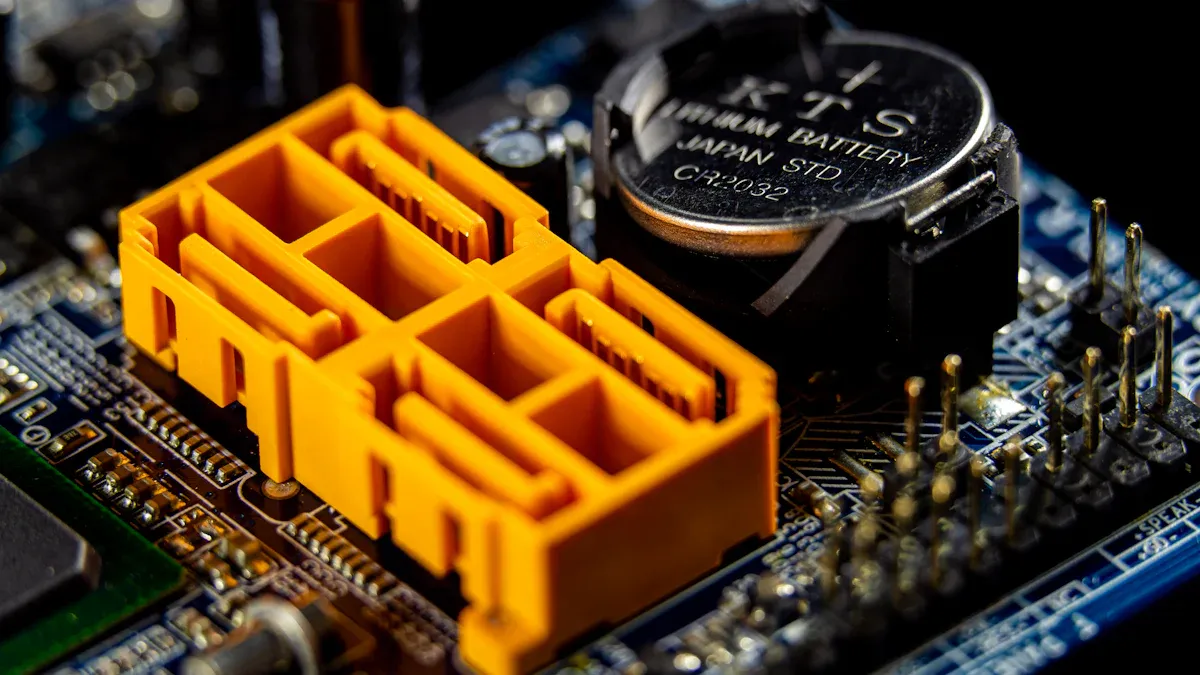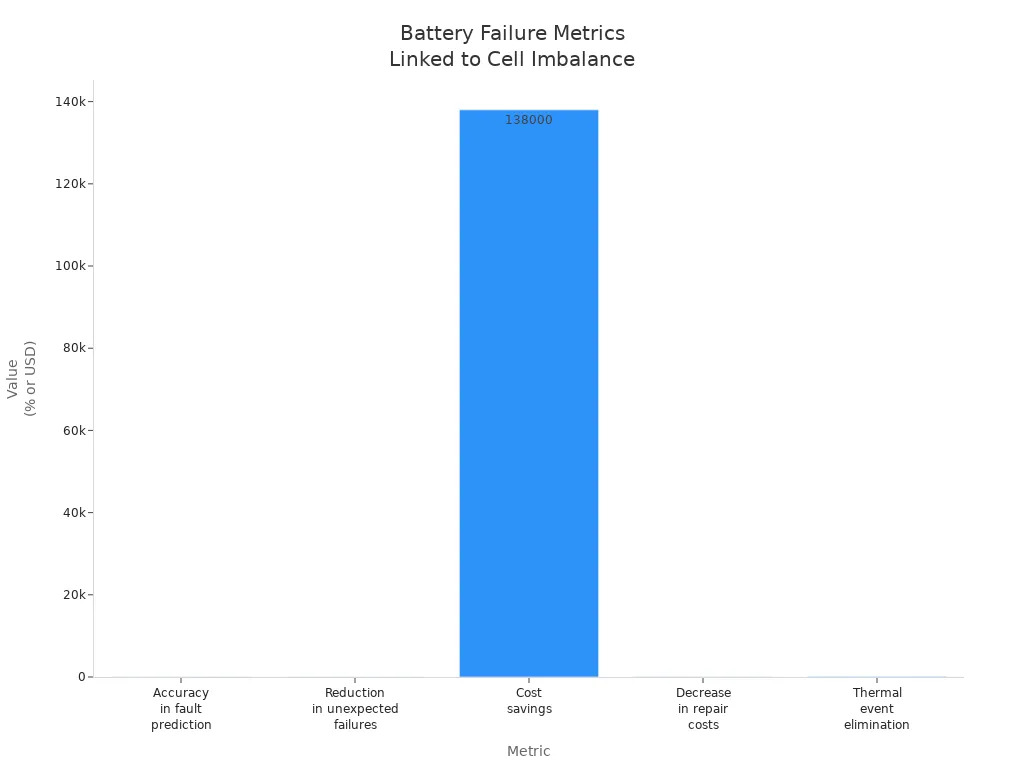
You might have seen a lithium-ion battery lose power faster than expected. This often happens because the cells inside the battery become unbalanced. When you use a battery balancer, you help each cell work together. Battery balancing keeps weaker cells from degrading quickly. Without balancing, one weak cell can lower the battery’s lifespan and cause early failure. Research shows that a balancer can increase battery longevity by up to six times compared to unbalanced packs. Balancing also improves safety and keeps your battery running strong. Battery balancing and a good balancer protect your investment and give you peace of mind.
Tip: Using a battery balancer with a battery management system (BMS) helps you avoid costly replacements and ensures safety.
Battery Longevity Benefits
Extending Battery Life
You want your lithium-ion battery to last as long as possible. Using a battery balancer helps you achieve this goal. When you keep all the cells balanced, you prevent one weak cell from dragging down the entire battery pack. This means you get more charge cycles and a longer battery lifespan.
Scientific studies show that battery balancing strategies, such as dividing the battery pack into different state-of-charge ranges, can optimize when balancing happens. These strategies help each cell reach a full charge and reduce the need for balancing during discharge. As a result, you extend battery longevity by reducing the wear that comes from imbalance.
Researchers have also developed active balancing algorithms that increase usable battery capacity by up to 16%. These methods make sure every cell charges and discharges fully, which means you get more out of your battery over time. Passive balancing techniques, like using a proportional-integral controller, also help by correcting voltage differences among cells. This keeps your battery healthy, improves energy efficiency, and reduces how often you need to replace your battery.
You can see how charge voltage affects cycle life in the table below:
| Charge Voltage (V) | Approximate Cycle Life Multiplier |
|---|---|
| 4.1 | 2x |
| 4.0 | 4x |
| 3.92 | 8x |

Note: Lowering the charge voltage and using a battery balancer together can greatly increase the number of cycles your battery can handle.
A battery balancer also lowers your total cost of ownership. By keeping your battery balanced, you avoid early replacements and save money. Active balancers use energy more efficiently and reduce heat, which helps your battery last even longer.
Boosting Performance
Balanced batteries do not just last longer—they also work better. When you use a battery balancer, you make sure each cell delivers power evenly. This means your battery can provide more energy and maintain strong performance throughout its life.
Cell voltage uniformity is key to battery performance. Even small differences in cell voltage or resistance can cause uneven current flow. This leads to some cells aging faster and losing capacity. If you keep your cells balanced, you avoid these problems and get the most out of your battery.
Statistical simulations with thousands of random charge imbalances show that active balancing techniques, like cell-to-cell and cell-to/from pack topologies, reduce balancing time and energy loss. These methods help your battery deliver more usable capacity and extend its lifespan. On the other hand, passive balancing is simple and low-cost but may waste more energy as heat, especially in large or high-performance systems.
Tip: Use a battery balancer with a good battery management system (BMS) to monitor and adjust cell voltages. This keeps your battery running safely and efficiently.
Temperature also affects how well your battery balancer works. If some cells get hotter than others, they age faster and become unbalanced. Advanced balancing strategies that consider temperature differences can reduce temperature gaps by up to 50%. This helps your battery stay safe and perform well, even under tough conditions.
Balanced battery packs show slower and more even degradation. After 2,000 cycles, unbalanced packs can lose up to 25% of their capacity, while balanced packs lose only about 5%. This means you get more reliable power and longer battery longevity.
A battery balancer protects your investment by improving both battery lifespan and performance. You get more energy, safer operation, and fewer worries about early failure.
Battery Balancing Explained

Why Balancing Matters
You may wonder why battery balancing is so important for your multi-cell battery pack. Each cell inside your battery can act a little differently. Even if you start with new cells, small differences from the manufacturing process can cause imbalance. Over time, charging and discharging cycles, storage, and even temperature changes make these differences grow. Cells can end up with different voltages and capacities. This leads to some cells working harder than others, which can shorten your battery’s life.
Here are some common causes of cell imbalance in a multi-cell battery pack:
- Manufacturing variations, such as differences in material or assembly
- Chemical and aging differences between cells
- Variations in internal resistance and connections
- Design factors, like how cells are arranged or connected
- Environmental factors, such as uneven exposure to heat or sunlight
When you use a battery balancer, you help each cell reach the same charge level. Battery balancing keeps all cells healthy and working together. If you skip balancing, your battery can lose capacity faster, and you may face safety risks. Active balancing methods move energy from stronger cells to weaker ones, which reduces stress and heat. This makes your battery safer and helps it last longer. Balancing also improves the accuracy of battery health predictions, so you can plan maintenance before problems start.
Tip: Regular battery balancing with a good balancer can slow down cell aging and keep your battery running at its best.
BMS and Balancers
A battery management system, or BMS, works with your battery balancer to protect your battery. The BMS watches each cell’s voltage, current, and temperature. It uses this information to control charging and discharging, keeping your battery within safe limits. The balancer, as part of the balancing system, makes sure every cell in your multi-cell battery pack stays at the right charge level.
The BMS and balancer work together to prevent overcharging and undercharging. This teamwork helps your battery deliver more power and last longer. The balancing system can use passive or active balancing. Passive balancing removes extra energy as heat, while active balancing moves energy between cells. Active balancing is more efficient and creates less heat, which is better for large or sensitive battery packs.
Battery management systems also provide safety features. They protect against short circuits, overheating, and other dangers. By using a battery balancer with your BMS, you get the best performance and safety from your battery. You can trust your battery to work well, whether you use it in an electric vehicle or for home energy storage.
Note: A strong battery management plan includes regular balancing, monitoring, and using the right balancer for your needs.
Battery Balancer Types

When you look at a battery balancer, you will see two main types: passive balancing and active balancing. Both play a big role in battery balancing, but they work in different ways to keep your battery healthy and safe.
Passive Balancing
Passive balancing is the simplest method you will find in a battery balancer. This type of balancing uses resistors to remove extra energy from cells with higher voltage. The extra energy turns into heat, which helps equalize the cell voltages. You often see passive balancing in smaller or less expensive battery packs because it is easy to use and costs less.
- Passive balancing includes:
- Resistive balancing
- Shunt balancing
- Discharge balancing
These methods help with battery balancing by making sure no cell gets overcharged. However, passive balancing wastes energy as heat. This can lower the efficiency of your battery and may require extra cooling in large battery packs. The heat can also affect safety if it builds up too much. Passive balancing works best during charging and is slower than other methods. It does not improve battery lifespan as much as other options.
请注意: Passive balancing is like cutting down the tallest board in a barrel to match the shortest, but you lose the extra wood instead of using it.
Active Balancing
Active balancing is a more advanced method you will find in a modern battery balancer. This type of balancing moves energy from cells with more charge to those with less. Instead of wasting energy, active balancing redistributes it, which makes your battery more efficient and helps it last longer.
- Active balancing uses:
- Capacitors or inductors to transfer charge
- Power electronics for energy redistribution
"(《世界人权宣言》) bidirectional buck-boost type is a common active balancer in commercial battery systems. It can balance several channels at once and includes safety features like over-voltage and under-voltage protection. Active balancing works during both charging and discharging, so your battery stays balanced all the time.
| 特点 | Passive Balancing | Active Balancing |
|---|---|---|
| Energy Handling | Excess energy as heat | Energy moved between cells |
| Efficiency | 低 | 高 |
| Heat Generation | 高 | 低 |
| Battery Lifespan | Minimal improvement | Significant improvement |
Active balancing improves battery balancing by reducing heat, increasing efficiency, and extending battery life. You get better performance and safety, especially in large or high-power battery packs. This method also helps your battery balancer keep your battery running longer and more reliably.
Tip: If you want the best battery balancing, choose a battery balancer with active balancing for higher efficiency and better safety.
Preventing Battery Issues
Risks of Imbalance
When you ignore battery balancing, you put your battery at risk. Imbalanced cells often lose charge at different rates. Over time, this leads to some cells reaching their voltage limits before others. Your battery balancer cannot protect the pack if one cell drops too low or rises too high. This causes the whole battery to stop working early, reducing battery capacity and wasting energy. You may notice your device shuts down sooner or charges more slowly.
Imbalance also speeds up cell aging. Cells that hit voltage extremes age faster and can fail early. If you use high charge or discharge currents, the state of charge mismatch gets worse. Uneven current flow creates heat, which stresses the cells and shortens battery life. In parallel packs, some cells carry more current and degrade faster. In series packs, the weakest cell limits the entire battery.
Safety becomes a real concern with imbalanced batteries. Overcharged or deeply discharged cells can overheat, short circuit, or even catch fire. Imbalanced cells may trigger thermal runaway, releasing flammable gases and causing explosions. The battery management system and balancer work together to prevent these hazards, but only if you keep your battery balanced.
| Metric | Value | 说明 |
|---|---|---|
| Accuracy in fault prediction | 91% | Early detection of battery faults, including imbalance |
| Reduction in failures | 84% | Fewer battery-related emergencies |
| Cost savings | $138,000 | Lower emergency and downtime costs |
| Decrease in repair costs | 62% | Less spent on repairs due to early intervention |
| Thermal event elimination | 100% | No fires or explosions with early imbalance detection |

Note: Early detection and regular battery balancing can prevent dangerous failures and save money.
Safety and Maintenance
You can prevent most battery issues by following simple maintenance steps. Start by using a battery balancer and a reliable balancing system. Regular cell monitoring helps you spot problems before they become serious. Many modern battery management systems offer advanced cell monitoring, tracking voltage, temperature, and current for each cell.
Follow the 20-80 rule for charging. Keep your battery between 20% and 80% charge for daily use. This reduces stress, heat, and aging. Avoid deep discharges below 20% and full charges above 80% unless needed for calibration or long trips. This practice helps maintain balanced cells and extends battery life.
Here are some practical tips for battery balancing and safety:
- Use only approved chargers with intelligent charging logic.
- Charge at moderate rates and avoid overnight charging.
- Store batteries at about 50% charge in a cool, dry place.
- Clean terminals and handle batteries gently to prevent damage.
- Monitor battery run time and charge status to catch imbalance early.
- Schedule regular inspections and follow manufacturer guidelines.
Tip: Regular maintenance and battery balancing with a quality balancer keep your battery safe, reliable, and long-lasting.
By making battery balancing and maintenance part of your routine, you protect your investment and avoid costly repairs. A good battery balancer, paired with a strong battery management plan, ensures your battery stays safe and performs at its best.
You can maximize your lithium-ion battery’s life and safety by using a battery balancer. Regular balancing keeps each cell healthy, prevents overcharging, and helps your battery deliver strong performance for years. Experts recommend balancing every six months to keep voltage differences in check.
- Choose passive balancing for smaller packs or active balancing for electric vehicles and high-demand systems.
- Always follow a maintenance schedule and use protection circuits for added safety.
By following these steps, you protect your investment and enjoy reliable power every day.
常见问题
What does a battery balancer do?
A battery balancer keeps all cells in your battery at the same voltage. This helps your battery last longer and work better. You avoid problems like early failure or safety risks.
How often should you balance your lithium-ion battery?
You should balance your battery every six months. If you use your battery often or in tough conditions, check it more often. Regular balancing helps you catch problems early.
Can you use any balancer with your battery pack?
You need to choose a balancer that matches your battery type and size. Always check your battery’s manual or ask the manufacturer. Using the wrong balancer can damage your battery.
What are signs of an unbalanced battery?
- Your battery charges slowly.
- The run time drops quickly.
- Some cells get hotter than others.
Tip: Use a battery management system (BMS) to spot these issues early.

